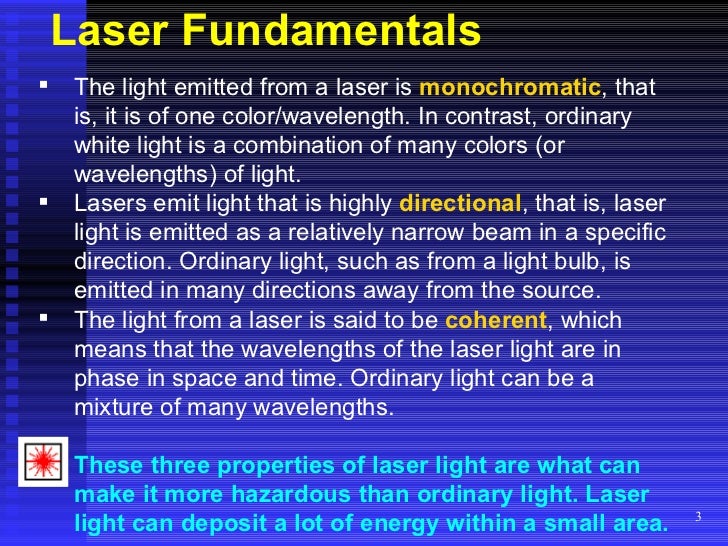Basic Laser Physics Pdf

Among the outstanding achievements of science and engineering in the 20th century, the laser occupies by right a major position. First lasers made in 1960 paved the way for the vehement development of laser technology. Today, lasers and laser systems find wide lise in many fields of science and engineering.
Card Rescue Mac Serial Info. They are employed in communications systems, computers, navigation equipment, measuring instruments, and in complicated technological processes. Biology, medicine, and various chemical and physical investigations utilize lasers to advantage. Wide use of lasers in science and technology is due to the specific properties of laser radiation. The laser is a generator of coherent light. Unlike other sources of light, such as incandescent lamps or arc lamps, the laser produces radiation with a highly regular light field, outstanding in its high coherence, monochromaticity and directivity. The discussion of lasers in this book begins with the evaluation of the physics of processes resulting in coherent optical radiation in the laser.
73 FUNDAMENTALS OF PHOTONICS Module 1.3 Basic Geometrical Optics Leno S. Pedrotti CORD Waco, Texas Optics is the cornerstone of photonics systems and applications. This chapter discusses the basic elements of laser science. An individual user may print out a PDF of a single chapter of a. 6 Basic elements of laser physics. Basic Laser Physics Pdf Textbook 36.4 1 Introduction to Laser Technology OEM ASK ABOUT OUR CUSTOM CAPABILITIES Introduction to Laser. Quantum cascade laser - Wikipedia. Quantum cascade lasers (QCLs) are semiconductor lasers that emit in the mid- to far- infrared portion of the electromagnetic.
This is the subject to Chapter 1. Chapter 2 takes up the classification of lasers and the physical and engineering benefits of various types of lasers.
Application of lasers puts in the forefront the control of laser radiation. This includes not only such aspects of beam control as deflection, scanning and modulation, but also the variation of the regime of oscillation to produce radiation with the desired spatial, temporal, frequency and power characteristics. All these topics are treated in Chapter 3.
Finally, Chapter 4 is concerned with diverse applications of lasers in science and engineering. The book was translated from the Russian by M. Edelev and was first published by Mir Publishers in 1986.
780: Intro to Lasers Introduction To Lasers Phone: 292-7035 Office: 4180, Physics Research Building. Office hours: By appointment. Physics 780.20, Section 0030-SEM(21635) MW @ 3:30 - 5:18 Caldwell Lab 0133 Text: Principles of Lasers, 5th Ed.
By Orazio Svelto Jump Station Information on this page: Other pages: Announcements January 4. First day of class. Lecture notes section created. Go download the notes for next Monday's lecture (starting on page 17). Lecture notes Lecture Notes 2/22 1/9 2/27 1/18 2/29 1/23 3/5 1/30 3/7 2/1 2/6 2/8 2/13 2/20 Homework Homework (solutions in pdf format) #1 #2 #3 #4 #5 #6 #7 Applets From Various Sites Basic Laser Concepts (Many of these are from site.) Computer generated idealized case, as opposed to the handout I gave you.
Shows your location in the stability diagram as you modify cavity parameters. Find a configuration that gives you a large mode everywhere.
Try other variations. You select the pump/loss/decay parameters and it solves the rate equations. Excellent for understanding self-Q-switching, transient response, and the approach to steady-state.
Ultrashort Pulse Laser concepts Uses your speakers so you can hear the result. There are a couple movies at this site near the bottom of the page. Probably not anything you don't already understand (after taking this course), but satisfying to watch anyway.
Simple illustration of how a wave looks when differing speeds are used. Try it at the highest frequency and follow the motion near the node in the envelope function. Allows you to superpose two arbitrary waves specified using C-like syntax. Other concepts Illustrated for reflection and refraction.